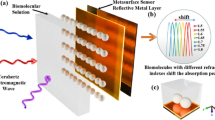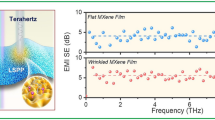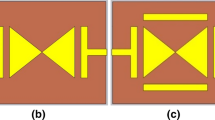Abstract
In the fields of communication and sensing, resonance bandwidth is a very critical index. It is very meaningful to implement a broadband resonance device with a simple metamaterial structure in the terahertz band. In this paper, we propose a simple metamaterial structure which consists of one horizontal metal strip and two vertical metal strips. This structure can achieve an electromagnetically induced transparency-like (EIT-like) effect in the frequency range of 0.1~3.0 THz to obtain a transparent window with a resonance bandwidth as high as 1.212 THz. When the relative distance between two vertical metal strips is changed, the bandwidth can be effectively controlled. Furthermore, we found that the EIT-like effect can be actively adjusted by replacing vertical metal strips with photosensitive silicon.







Similar content being viewed by others
References
Suzuki T, Sekiya M, Sato T, Takebayashi Y (2018) Negative refractive index metamaterial with high transmission, low reflection, and low loss in the terahertz waveband. Opt Express 26:8314–8324
Rosenblatt G, Orenstein M (2015) Perfect lensing by a single interface: defying loss and bandwidth limitations of metamaterials. Phys Rev Lett 115:195504
Schurig D, Mock JJ, Justice BJ, Cummer SA, Pendry JB, Starr AF, Smith DR (2006) Metamaterial electromagnetic cloak at microwave frequencies. Science 314:977–980
Schueler M, Mandel C, Puentes M, Jakoby R (2012) Metamaterial inspired microwave sensors. IEEE Microw Mag 13:57–68
Wang BX, Tang C, Niu Q, He Y, Chen T (2019) Design of narrow discrete distances of dual−/triple-band terahertz metamaterial absorbers. Nanoscale Res Lett 14:64
Keshavarz A, Vafapour Z (2019) Sensing avian influenza viruses using terahertz metamaterial reflector. IEEE Sensors J 19:5161–5166
Chen HT, Padilla WJ, Cich MJ, Azad AK, Averitt RD, Taylor AJ (2009) A metamaterial solid-state terahertz phase modulator. Nat Photonics 3(3):148–151
Wang BX (2017) Quad-band terahertz metamaterial absorber based on the combining of the dipole and quadrupole resonances of two SRRs. IEEE J Sel Top Quantum Electron 23:4700107
Wang BX, Wang GZ, Sang T (2016) Simple design of novel triple-band terahertz metamaterial absorber for sensing application. J Phys D Appl Phys 49:165307
Wang BX, Wang GZ, Wang LL (2016) Design of a novel dual-band terahertz metamaterial absorber. Plasmonics 11:523–530
Nikolaenko AE, Papasimakis N, Chipouline A, De Angelis F, Di Fabrizio E, Zheludev NI (2012) THz bandwidth optical switching with carbon nanotube metamaterial. Opt Express 20:6068–6079
Wang BX, He Y, Lou P, Xing W (2020) Design of a dual-band terahertz metamaterial absorber using two identical square patches for sensing application. Nanoscale Adv 2:763–769
García-García J, Bonache J, Gil I, Martín F, Velazquez-Ahumada MC, Martel J (2006) Miniaturized microstrip and CPW filters using coupled metamaterial resonators. IEEE Trans Microw Theory Tech 54:2628–2635
Wang BX, Wang GZ, Wang LL, Zhai X (2016) Design of a five-band terahertz absorber based on three nested split-ring resonators. IEEE Photon Technol Lett 28:307–310
Cheben P, Čtyroký J, Schmid JH, Wang S, Lapointe J, Wangüemert-Pérez JG et al (2019) Bragg filter bandwidth engineering in subwavelength grating metamaterial waveguides. Opt Lett 44:1043–1046
Fleischhauer M, Imamoglu A, Marangos JP (2005) Electromagnetically induced transparency: optics in coherent media. Rev Mod Phys 77:633–673
Khurgin JB (2005) Optical buffers based on slow light in electromagnetically induced transparent media and coupled resonator structures: comparative analysis. J Opt Soc Am B 22:1062–1074
Zhang J, Hernandez G, Zhu Y (2008) Slow light with cavity electromagnetically induced transparency. Opt Lett 33:46–48
Liu T, Wang H, Liu Y, Xiao L, Zhou C, Liu Y, Xu C, Xiao S (2018) Independently tunable dual-spectral electromagnetically induced transparency in a terahertz metal–graphene metamaterial. J Phys D Appl Phys 51:415105
Heinze G, Hubrich C, Halfmann T (2013) Stopped light and image storage by electromagnetically induced transparency up to the regime of one minute. Phys Rev Lett 111:033601
Hsu MT, Hetet G, Gloeckl O, Longdell JJ, Buchler BC, Bachor HA, Lam PK (2006) Quantum study of information delay in electromagnetically induced transparency. Phys Rev Lett 97:183601
Meng FY, Wu Q, Erni D, Wu K, Lee JC (2012) Polarization-independent metamaterial analog of electromagnetically induced transparency for a refractive-index-based sensor. IEEE Trans Microw Theory Tech 60:3013–3022
Yadipour R, Abbasian K, Rostami A, Koozekanani ZD (2007) A novel proposal for ultra-high resolution and compact optical displacement sensor based on electromagnetically induced transparency in ring resonator. Prog Electromagn Res 77:149–170
Liu T, Wang H, Liu Y, Xiao L, Yi Z, Zhou C, Xiao S (2018) Active manipulation of electromagnetically induced transparency in a terahertz hybrid metamaterial. Opt Commun 426:629–634
Paternostro M, Kim MS, Ham BS (2003) Generation of entangled coherent states via cross-phase-modulation in a double electromagnetically induced transparency regime. Phys Rev A 67:023811
Xiao S, Wang T, Liu T, Yan X, Li Z, Xu C (2018) Active modulation of electromagnetically induced transparency analogue in terahertz hybrid metal-graphene metamaterials. Carbon 126:271–278
Zografopoulos DC, Swillam M, Beccherelli R (2016) Hybrid plasmonic modulators and filters based on electromagnetically induced transparency. IEEE Photon Technol Lett 28(7):818–821
Lu H, Liu X, Wang G, Mao D (2012) Tunable high-channel-count bandpass plasmonic filters based on an analogue of electromagnetically induced transparency. Nanotechnology 23:444003
Davanço M, Holmstrom P, Blumenthal DJ, Thylén L (2003) Directional coupler wavelength filters based on waveguides exhibiting electromagnetically induced transparency. IEEE J Quantum Electron 39:608–613
Jeong T, Bae IH, Moon HS (2017) Noise filtering via electromagnetically induced transparency. Opt Commun 383:31–35
Schmidt H, Ram RJ (2000) All-optical wavelength converter and switch based on electromagnetically induced transparency. Appl Phys Lett 76:3173–3175
Clarke J, Chen H, van Wijngaarden WA (2001) Electromagnetically induced transparency and optical switching in a rubidium cascade system. Appl Opt 40:2047–2051
Rao S, Hu X, Xu J, Li L (2017) Optical switching of cross intensity correlation in cavity electromagnetically induced transparency. J Phys B Atomic Mol Phys 50(5):055504
Harris SE, Field JE, Imamoğlu A (1990) Nonlinear optical processes using electromagnetically induced transparency. Phys Rev Lett 64:1107–1110
Zhang GZ, Hakuta K, Stoicheff BP (1993) Nonlinear optical generation using electromagnetically induced transparency in atomic hydrogen. Phys Rev Lett 71(19):3099–3102
Hao L, Xue Y, Fan J, Jiao Y, Zhao J, Jia S (2019) Nonlinearity of microwave electric field coupled Rydberg electromagnetically induced transparency and Autler-Townes splitting. Appl Sci 9:1720
Hu S, Yang HL, Chen J, & Huang XJ (2016) Study of dual-spectral electromagnetically induced transparency in bright-dark mode coupling metamaterials. In 2016 11th International Symposium on Antennas, Propagation and EM Theory (ISAPE). IEEE, (pp. 488-491)
Yahiaoui R, Burrow JA, Mekonen SM, Sarangan A, Mathews J, Agha I, Searles TA (2018) Electromagnetically induced transparency control in terahertz metasurfaces based on bright-bright mode coupling. Phys Rev B 97:155403
Hu S, Liu D, Lin H, Chen J, Yi Y, Yang H (2017) Analogue of ultra-broadband and polarization-independent electromagnetically induced transparency using planar metamaterial. J Appl Phys 121:123103
Wu C, Khanikaev AB, Shvets G (2011) Broadband slow light metamaterial based on a double-continuum Fano resonance. Phys Rev Lett 106:107403
Han S, Yang H, Guo L (2013) Ultra-broadband electromagnetically induced transparency using tunable self-asymmetric planar metamaterials. J Appl Phys 114:163507
Cheng YZ, Nie Y, Cheng ZZ, Wu L, Wang X, Gong RZ (2013) Broadband transparent metamaterial linear polarization transformer based on triple-split-ring resonators. J Electromagn Waves Appl 27:1850–1858
Acknowledgments
This research was funded by the National Natural Science Foundation of China (11647143), Natural Science Foundation of Jiangsu (BK20160189), China Postdoctoral Science Foundation (2019 M651692), Jiangsu Postdoctoral Science Foundation (2018K113C), and Fundamental Research Funds for Central Universities (JUSRP51721B).
Author information
Authors and Affiliations
Corresponding author
Additional information
Publisher’s Note
Springer Nature remains neutral with regard to jurisdictional claims in published maps and institutional affiliations.
Rights and permissions
About this article
Cite this article
He, Y., Wang, BX., Lou, P. et al. Resonance Bandwidth Controllable Adjustment of Electromagnetically Induced Transparency-like Using Terahertz Metamaterial. Plasmonics 15, 1997–2002 (2020). https://doi.org/10.1007/s11468-020-01228-1
Received:
Accepted:
Published:
Issue Date:
DOI: https://doi.org/10.1007/s11468-020-01228-1




